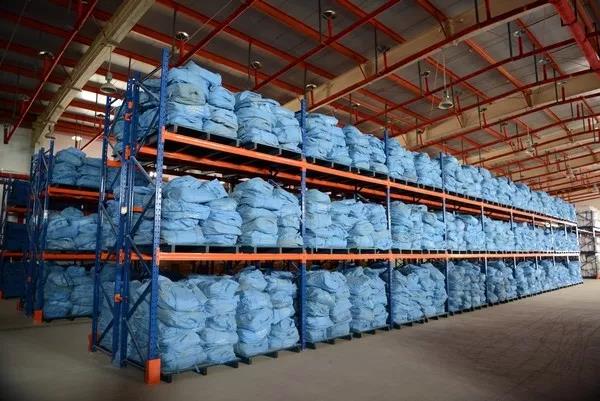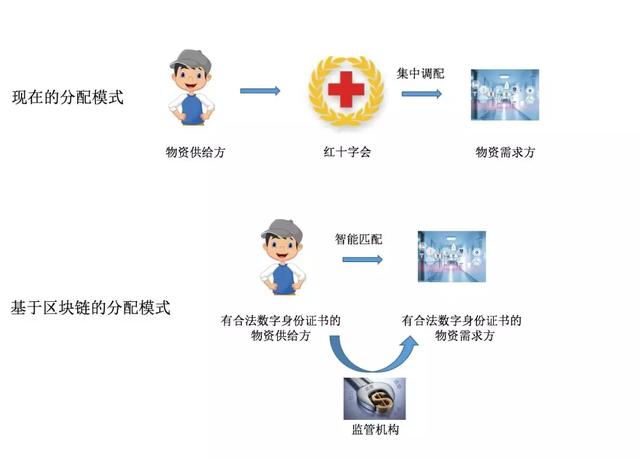Where did the supplies go? Questions that Wuhan Red Cross cannot answer, blockchain can

Head picture from the network
By Wang Qiao
Edit / Sole Show
- 2019 DeFi industry research report: DeFi industry will become the best application scenario for blockchain landing in vertical industry
- Ethereum 2.0 development team AMA: Phase 0 will be deployed as early as 3 months
- Court dismisses United American lawsuit against Bitmain
This article first appeared on WeChat public account zinc link (ID: xinlianjie-), pay attention to the public account, and explore the value of the industrial blockchain with us. If you need to reprint the article, please apply for white list on WeChat.
At the beginning of the new year, the number of confirmed cases in the country's war was "increasing." From hundreds, thousands, and tens of thousands, the increase in the number affects the hearts of every country. Rescue supplies arrived in Wuhan one after another, however, the supplies were piled up in the warehouse of the Wuhan Red Cross, and they could not be sent out.
The death of life-saving medical supplies at the "last mile" is undoubtedly the most distressing.
The reason is the inefficiency of material management and opaque information. In a short period of time, large quantities of materials have become "extraordinary examination questions" for the Red Cross Society. The public has no idea about the whereabouts of donated materials.
Aiming at the problems of low efficiency, chaotic management, and unfair distribution within the Red Cross, Liu Mingrui told Zinc Link that the spread of the "virus" has "exponential power", and the Red Cross uses a backward "linear" system to deal with the exponential crisis Are difficult to succeed. Moreover, the transmission of "viruses" is usually accompanied by great uncertainty, complexity, and requires extremely high timeliness.
Where did the supplies go? This Wuhan Red Club can't answer questions, such as blockchain technology.
Professor of Tsinghua University School of Journalism and Communication, Weibo Da V "New Media Shenyang" said on Weibo that the distribution of materials and the push of information are similar in nature. Information push today has come to the age of intelligent recommendation, and the distribution of materials should also introduce AI, blockchain, cloud computing and big data (ABCD), and all members of the entire process can query it.
I. Material information on the chain
First of all, the consistent opacity of the information has led to a serious lack of credit for the Red Cross. Only when the data is transparent can it be easily monitored by the public. It can be found whether the distribution amount is real, the distribution process is fast, and the distribution result is fair.
Xuan Hongliang, the founder of WeSpace Trusted Digital Ecology, told Zinc Link that blockchain is a "self-certified and trusted" system. Any organization that provides public services or product production and sales, dares to upload the core data, indicating that it dares to “self-certify innocence”; if it does not dare to upload, once the mistakes in the work are made public, it will certainly be more questioned by the public.
He believes that cloud computing and blockchain technology can be used to build a credible medical material management system and promote innovation in medical material management models. That is to say, on the basis of the original management model, increase the issuance and upload of core data of key nodes. Through cloud-chain collaboration, the cloud is responsible for data calculation, evidence storage, and data querying, and the chain-end is responsible for trusted data and trusted evidence storage and verification. The client provides data collection and cloud-chain interaction to create a brand-new trusted public service system.
Secondly, in order to solve the problem of medical material distribution, the entire process must be completely disclosed. Whether it is a donor, the public, or the demand side, the flow of each item can be clearly seen, so that each item can be implemented.
Tang Bo, chief scientist of Changhong Information Security Lab, told Zinc Link: " The front-end and back-end data need to be connected to make the donation data and distribution data public . Participating roles include donors, distributors and supervisors. Secondly, they need to clarify their respective rights and obligations. Enforced by the system. "
According to the Beijing News, Zhang Nandiyang, dean of the National Development and Strategic Research Institute Qingdao Branch of Renmin University of China, and associate professor of the School of Public Management also believes that traditional resources are difficult to achieve comprehensive real-time social sector cross-sectoral and cross-domain social resource allocation. Information sharing and openness.
"Facing the public health crisis, using blockchain technology to build a material chain, to achieve data integration of materials available from all sectors of society, real-time understanding of the amount of physical assets, inventory, and tracking transportation nationwide. Under the blockchain technology, materials began The place of origin, direction, stranded place, and distribution can be recorded on the chain in real time, the data is stored at multiple points, and announced to the society. The distribution of materials is clearly visible. The entire society can jointly monitor, improve the efficiency of resource allocation, and strengthen social trust. . "
Recently, FunChain Technology has joined forces with Haier Zhijia, China Xiong'an Group and other companies to start research and development of a "donation material traceability platform".
According to the assumption, many institutions at home and abroad are distributed on this platform. Whenever someone or an organization wishes to donate a batch of materials to a certain institution, as long as they simply register on the platform, they can see the donation details, logistics tracking, and material receipt. And material implementation, and we can also see the demand dynamics in real time. The whole process can be traced to the source and difficult to tamper with. It solves the three major problems of "difficult to demand, difficult to donate, and hard to believe by the masses."
According to Zinc Link, the project is expected to be launched in February.
In addition, in order to make the whole process open and transparent, we also need to rely on the Internet of Things technology. Yuan Dongyang, the director of the German Fangzhichain Financial Research Office, told Zinc Link to combine information about the type, quantity, distribution requirements, assigned objects, distribution requirements, and distribution results of materials , as well as the displacement, time, and status of materials collected by the Internet of Things. Information is chained, and is open to distributors, assignees, government agencies, logistics companies and other entities to achieve data sharing and comparison, which can ensure that all information about material distribution is transparent, timely, and truthfully learned by all parties, avoiding Loss and mismatch of materials to improve the timeliness and accuracy of material distribution.
From a technical perspective, blockchain can indeed be open and transparent, but the founder and CEO of ArcBlock Mao Zhihong believes that there are still organizational, institutional, and legal issues. IT systems are for people, especially for systems such as donated materials. First of all, we must ensure that the data itself is accurate and it makes sense to put it on the chain. Secondly, we must ensure that the implementation is in place. The chain can only guarantee the state on the chain and cannot guarantee it. Is it really implemented?
Second, digital identity, intelligent matching materials
After the whole process of medical supplies is open and transparent, legal digital identity certificates are issued for the medical supplies demand units and supply units, so that the released demand and supply information is true and effective, so that it can reasonably and correctly match the real needs, so that the medical supplies can make the most of their effectiveness.
Yuan Yunliang, the technical director of German Fangzhichain, told Zinc Link that legal digital identities will be issued for medical material demand units and supply units. Medical material demand units will put demand on the chain in terms of class, number, quality and other dimensions. According to the corresponding dimensions of the chain, online intelligent matching, material point-to-point allocation, full link traceability, and the introduction of regulatory agencies for audit. The demand and supply sides maintain daily data maintenance and updates. The entire material allocation process is transparent and efficient, and the reasonable and correct allocation of medical materials is accelerated.
Yuan Yunliang added that only platforms with a valid digital identity certificate can use the platform to publish demand, provide supply information, prevent illegal and untrue demand and supply information, and ensure information accuracy. Secondly, smart matching and point-to-point distribution can be done without going through the middle party (Wuhan Red Cross).

(Image source: drawn by the author)
The supply side directly connects with the demand side, and the understanding of demand will be more accurate, and the allocation of materials will be faster.
Third, the index crisis requires an "index organization"
To cope with an exponential crisis, we need a more efficient and resilient future system. As pointed out by Salem Ismail of Singularity University in "Exponential Organization", I believe that the core of the future system lies in self-organization, community and public, information credibility and network collaboration. The immutable, traceable, and fully transparent nature of blockchain technology can play a central role in future systems.
Liu Mingrui told Zinc Link: "In the past, the strong standard of the system was how many resources it possessed, and in the future, the strong standard of the system was how to make the resources flow efficiently. Even if a traditional organization such as the Red Cross has more resources, it ca n’t mobilize resources efficiently. It is destined not to be a powerful system for dealing with crises.

(Image source: Respondents provided)
Each exponential organization has a grand goal full of sense of change. When there is such a grand goal, the internal contradictions of the entire organization will be reduced, and it will become consistent and external. Second, index organizations do not have a large number of employees, but there are a large number of people working, and the most valuable things are provided by the community and the public. You don't need to have your own professionals, you just need to provide them with a platform, the community and the public will contribute a lot of power.
In the future, rights will shift from the core to the edges. In the future, to cope with social uncertainty, a new type of organization empowered by next-generation information technology is needed. "
In this outbreak, the power of science and technology can be seen everywhere.
For example, at Wuhan Vulcan Mountain Hospital, Huawei cooperated with the three major operators to build a 4 / 5G wireless network and dedicated line network in just 4 days; AI has also become an important blessing force for frontline medical staff. The original hours of genetic analysis of suspected cases was shortened to half an hour, greatly reducing the diagnosis time and accurately detecting the mutation of the virus. In addition, in order to further accelerate the development and marketing of new vaccines and drugs, many domestic technology companies such as BAT Scientific research institutions open their own AI computing power for free.
However, participation in technology is still far from enough. The Wuhan Red Society is a typical example. No matter how loud the slogan of the digital economy is, the "short board" at critical moments is enough to expose many problems of digital popularization.
I hope that when we are facing the same difficulties again, there will be more technological help: there are blockchain technologies that can help information transparency; there is the Internet of Things to track the flow of medical supplies, and to ensure the authenticity of the on-chain data; there are clouds The calculation performs rapid calculation of massive data; and issues legal digital identities for medical material demand units and supply units, which can reasonably match demand and allow medical materials to maximize their effectiveness.
We will continue to update Blocking; if you have any questions or suggestions, please contact us!
Was this article helpful?
93 out of 132 found this helpful
Related articles
- Monthly Report | Global Blockchain Private Equity Financing Declined 80% in January, Sino-US Market Cooled Down
- Former European Central Bank Deputy Governor: Consumer-oriented central bank digital currency will wait another 10 years
- Ripple partners with Nasdaq-listed company to support US-Mexico cross-border payments
- Both challenges and opportunities, this team hopes to run Ethereum 2.0 testnet with mobile phones
- OMFIF / MORI survey: The most trusted digital currency issuer is indeed TA!
- Beijing introduced "16" measures to promote the development of small, medium and micro enterprises, including the construction of a blockchain-based supply chain debt and debt platform
- Beijing: To cope with the impact of the epidemic, build a blockchain-based supply chain debt and debt platform





